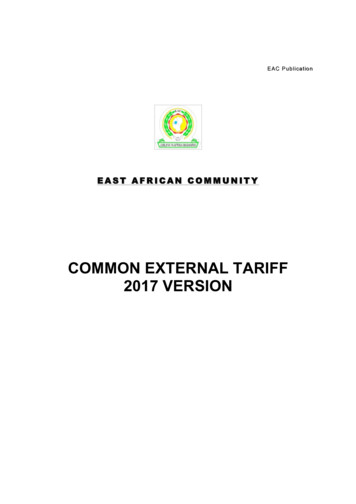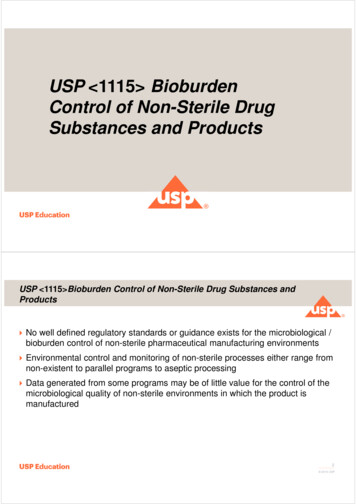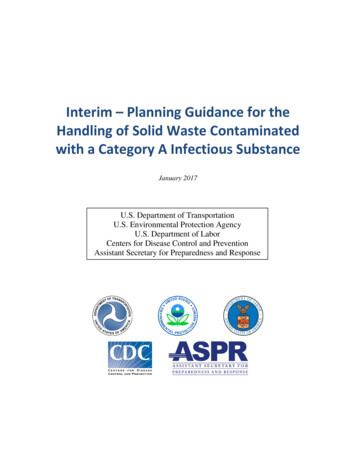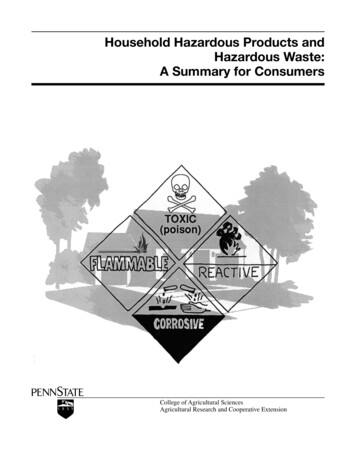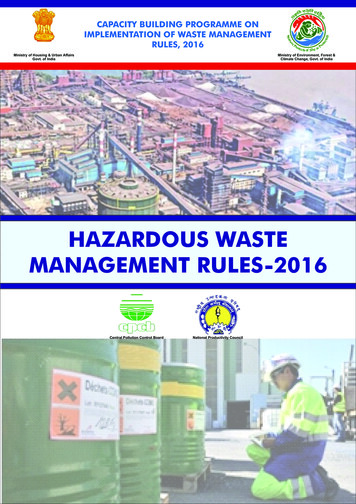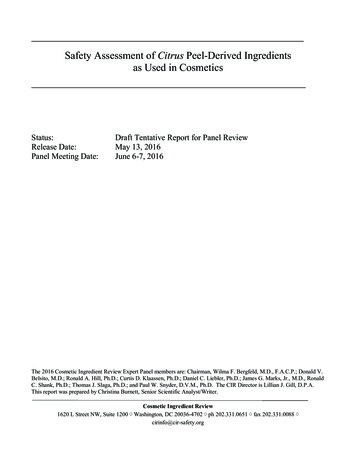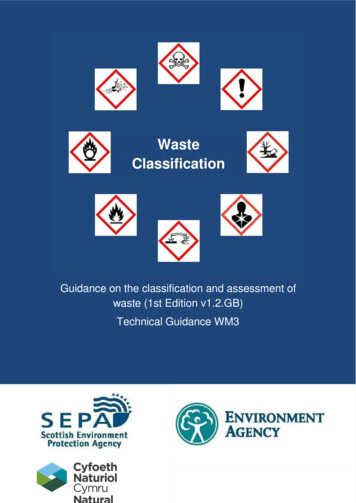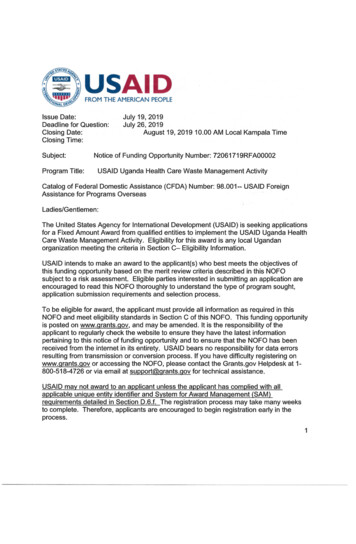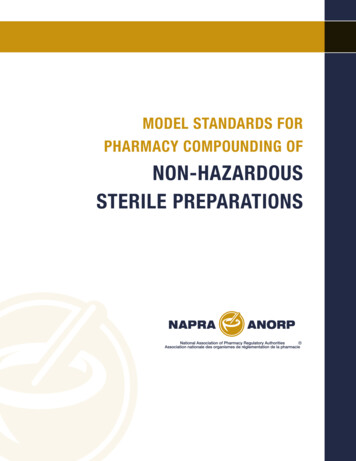
Transcription
MODEL STANDARDS FORPHARMACY COMPOUNDING OFNON-HAZARDOUSSTERILE PREPARATIONS
Model Standards for Pharmacy Compounding of Non-hazardous Sterile PreparationsApproved by the National Association of Pharmacy Regulatory Authorities’ (NAPRA) Board of Directors April 2015,published November 2015.Revision November 2016 (Sterilization by Filtration in the Glossary corrected to 30 psi from 50 psi previouslypublished).Adapted with permission from “Préparation de produits stériles non dangereux en pharmacie – Norme 2014.01”,Ordre des pharmaciens du Québec, 2014. National Association of Pharmacy Regulatory Authorities, 2015. All rights reserved.No part of this document may be reproduced in any form by any photographic, electronic, mechanical or othermeans, or used in any information storage and retrieval system, without the written permission of the author.The National Association of Pharmacy Regulatory Authorities (NAPRA)130 Albert Street, Suite 1800, Ottawa, ON K1P 5G4E-mail: info@napra.ca Telephone: (613) 569-9658 Fax (613) 569-9659
ACKNOWLEDGEMENTSThe National Association of Pharmacy Regulatory Authorities (NAPRA) would like tofirst thank one of its members, the Ordre des pharmaciens du Québec, for having madepossible the adaptation of its document entitled “Préparation de produits stériles nondangereux en pharmacie – Norme 2014.01” to create this national document, “ModelStandards for Pharmacy Compounding of Non-hazardous Sterile Preparations.”This adaptation would not have been possible without the work and dedication of themembers of the NAPRA ad hoc Committee on Pharmacy Compounding. Special thanksare extended to these individuals:- Ronald Guse, Registrar, College of Pharmacists of Manitoba (Chair)- Bob Nakagawa, Registrar, College of Pharmacists of British Columbia- Marshall Moleschi, Registrar, Ontario College of Pharmacists- Susan Wedlake, Registrar, Nova Scotia College of Pharmacists- Carole Bouchard, Executive Director, NAPRA (ex officio)The Committee was supported by a number of individuals with various types of expertisein this area, whose technical contributions were instrumental in completing the ModelStandards. Special thanks are also extended to these individuals:- Meechen Tchen, pharmacist consultant, NAPRA- Judy Chong, Manager, Hospital and Other Healthcare Facilities, Ontario Collegeof Pharmacists- Cameron Egli, formerly Director, Hospital Pharmacy Practice and Technology,College of Pharmacists of British Columbia- Danielle Fagnan, Directrice des services professionnels, Ordre des pharmaciensdu Québec- Bal Dhillon, pharmacy technician, British Columbia- Eric S. Kastango, President/CEO of Clinical IQ, LLC and CriticalPoint, LLC.
N AT I O N A L A S S O C I AT I O N O F P H A R M A C Y R E G U L AT O RY A U T H O R I T I E S ( N A P R A )CONTENTS1.INTRODUCTION32.OBJECTIVES43.REGULATORY FRAMEWORK54.ABBREVIATIONS75.CORE REQUIREMENTS FOR A STERILE COMPOUNDING SERVICE85.1Personnel85.2Policies and procedures155.3Facilities and equipment155.4General maintenance log356.7.PRODUCT AND PREPARATION REQUIREMENTS366.1Beyond-use date and dating methods366.2Compounded sterile preparation protocols406.3Compounded sterile preparation log416.4Patient file436.5Conduct of personnel in areas reserved for the compounding of sterile preparations436.6Aseptic compounding of non-hazardous sterile rt and delivery of compounded sterile preparations536.10Recall of sterile products or final compounded sterile preparations546.11Incident and accident management546.12Waste management54QUALITY ASSURANCE PROGRAM557.1Program content557.2Results and action levels557.3Verification of equipment and facilities557.4Quality assurance of personnel involved in aseptic compounding607.5Quality assurance of compounded sterile preparations617.6Documentation of quality control activities628.SOURCE FOR ADDITIONAL INFORMATION639.GLOSSARY6410. LIST OF TABLES69MODEL STANDARDS FOR PHARMACY COMPOUNDING OF NON-HAZARDOUS STERILE PREPARATIONS1
N AT I O N A L A S S O C I AT I O N O F P H A R M A C Y R E G U L AT O RY A U T H O R I T I E S ( N A P R A )11. APPENDICES70Appendix 1Policies and procedures for the compounding of non-hazardous sterile preparations70Appendix 2Mandatory and supplemental references72Appendix 3Training of compounding personnel and cleaning and disinfecting personnel73Appendix 4Procedure template75Appendix 5Minimum indicators for certification of controlled areas and primary engineering control77Appendix 6Certification of controlled areas, laminar airflow workbenches and biological safety cabinets79Appendix 7Template for the drafting of compounding protocols to be completed for each drug82Appendix 8Examples of sterile preparations that must be verified at each stage of compounding85Appendix 9Examples of sterile preparations that do not require verification during the compounding process86Appendix 10Temperatures for different types of storage87Appendix 11Incident/accident reporting and follow-up form88Appendix 12Components of a quality assurance program8912. BIBLIOGRAPHYMODEL STANDARDS FOR PHARMACY COMPOUNDING OF NON-HAZARDOUS STERILE PREPARATIONS912
N AT I O N A L A S S O C I AT I O N O F P H A R M A C Y R E G U L AT O RY A U T H O R I T I E S ( N A P R A )1. INTRODUCTIONThe compounding of sterile preparations requires high-quality standards to ensure preparation quality and safety.Parenteral therapies are becoming more complex, and patients may now receive continuous antibiotic therapy orchemotherapy, among other therapies, for several days at home. Consequently, greater attention must be paid to theenvironment in which these preparations are prepared, the training of personnel and quality assurance procedures toprevent complications and protect the public more generally.Evolving practice and increased awareness of the inherent dangers of compounding sterile preparations for the health ofboth patients and compounding personnel1, 2, 3, 4 led to the need to review the “Guidelines to Pharmacy Compounding”published by the National Association of Pharmacy Regulatory Authorities (NAPRA) in October 2006.The new NAPRA Model Standards for Pharmacy Compounding of Non-hazardous Sterile Preparations have beenadapted from standards originally developed by the Ordre des pharmaciens du Quebec, which are in turn based onGeneral Chapter 797 of the United States Pharmacopeia – National Formulary (USP–NF) in effect in the UnitedStates since 2004. Their preparation was led by the NAPRA ad hoc Committee on Pharmacy Compounding and involvedextensive consultation with experts and stakeholders.1Bussières JF, Prot S. Perspectives sur les préparations magistrales en pharmacie au Québec. Pharmactuel. 2004;37(3):File 1.2Selenic D, Dodson DR, Jensen B, Arduino MJ, Panlilio A, Archibald LK. Enterobacter cloacae bloodstream infections in pediatric patients traced to a hospitalpharmacy. Am J Health Syst Pharm. 2003;60(14):1440-6.3Patel PR, Larson AK, Castel AD, Ganova-Raeva LM, Myers RA, Roup BJ, et al. Hepatitis C virus infections from a contaminated radiopharmaceutical used inmyocardial perfusion studies. JAMA. 2006;296(16):2005-11.4Kastango ES. The cost of quality in pharmacy. Int J Pharm Compound. 2002;6(6):404-7.MODEL STANDARDS FOR PHARMACY COMPOUNDING OF NON-HAZARDOUS STERILE PREPARATIONS3
N AT I O N A L A S S O C I AT I O N O F P H A R M A C Y R E G U L AT O RY A U T H O R I T I E S ( N A P R A )2. OBJECTIVESThe aim of these Model Standards is to provide pharmacists and pharmacy technicians who compound non-hazardoussterile preparations with the standards necessary to evaluate their practice, develop service-related procedures andimplement appropriate quality controls for both patients and compounding personnel, with a view to guaranteeing theoverall quality and safety of sterile preparations. The Model Standards will come into effect in each province/territoryonce they have been adopted by the respective provincial/territorial pharmacy regulatory authorities.These Model Standards represent the minimum requirements to be applied in compounding sterile preparations;however, it is always possible to exceed these standards. The use of other technologies, techniques, materials andprocedures may be acceptable, so long as they are proven to be equivalent or superior to those described here.These Model Standards support NAPRA’s Model Standards of Practice for Canadian Pharmacists and PharmacyTechnicians5, 6, as well as other policies and guidelines that may be in place in provincial/territorial jurisdictions.5National Association of Pharmacy Regulatory Authorities (NAPRA). Model standards of practice for Canadian pharmacists. Ottawa, ON: NAPRA; 2009. Availablefrom: http://napra.ca/Content Files/Files/Model Standards of Prac for Cdn Pharm March09 Final b.pdf6National Association of Pharmacy Regulatory Authorities (NAPRA). Model standards of practice for Canadian pharmacy technicians. Ottawa, ON: NAPRA; 2011.Available from: techniciansstandards.aspxMODEL STANDARDS FOR PHARMACY COMPOUNDING OF NON-HAZARDOUS STERILE PREPARATIONS4
N AT I O N A L A S S O C I AT I O N O F P H A R M A C Y R E G U L AT O RY A U T H O R I T I E S ( N A P R A )3. REGULATORY FRAMEWORKCompounded sterile preparations are prepared by many health care professionals, including nurses, physicians,pharmacists and pharmacy technicians. However, the majority of sterile compounding is performed by pharmacypersonnel under the supervision of pharmacists. Although these standards could serve as best practices for other healthcare practitioners, they pertain specifically to pharmacists, pharmacy technicians and pharmacies where compoundedsterile preparations are prepared.The preparation of medications (pharmacy compounding) has always been an integral part of the practice of pharmacy.It is essential to the delivery of health care and allows for personalized therapeutic solutions to improve patient care.However, pharmacy compounding must always be carried out within a prescriber–patient–pharmacist relationship.Provincial/territorial pharmacy regulatory authorities are responsible for regulating a pharmacy’s compounding servicesin these situations.In situations involving requests to compound preparations outside of a prescriber–patient–pharmacist relationship,in the absence of a patient-specific prescription, the preparation activities fall under the federal legislative framework.For example, the bulk preparation of compounded preparations in the absence of a prescriber–patient–pharmacistrelationship would fall under the federal legislative framework.Health Canada is the federal department responsible for the Food and Drugs Act and the Controlled Drugs and SubstancesAct and their associated regulations. In January 2009, Health Canada developed its “Policy on Manufacturing andCompounding Drug Products in Canada”7. At the time these Model Standards were prepared, Health Canada wasexamining this policy with a view to creating new standards for situations not covered within the practice of pharmacyor under the current federal licensing framework, such as commercial compounding manufacturing.NAPRA’s professional competencies for Canadian pharmacists and pharmacy technicians at entry to practice provideguidance for developing an ethical, legal and professional practice. One of these competencies specifies that a pharmacistor pharmacy technician must seek guidance when uncertain about his or her own knowledge, skills, abilities or scope ofpractice. Therefore, individuals who do not have the knowledge, training, expertise, facilities or equipment required tocompound sterile products must refer patients to a colleague who does have the competencies and facilities required todo so or, where permitted by provincial/territorial legislation, ask another pharmacy to compound the product for them.Compounded sterile preparations include the following types of medications:7 nasal inhalation solutions respiratory therapy solutions solutions for live organ and tissue or graft baths injections (e.g., intramuscular, intravenous, intrathecal, intradermal, subcutaneous) irrigation solutions for wounds and body cavities (e.g., thoracic, spinal, abdominal, pelvic) ophthalmic drops and ointments otic drops for intratympanic administration parenteral nutrition dialysis solutionsHealth Canada, Health Products and Food Branch Inspectorate. Policy on manufacturing and compounding drug products in Canada. POL-051. Ottawa, ON: HealthCanada; 2009. Available from: bpf/docs/pol 0051-eng.phpMODEL STANDARDS FOR PHARMACY COMPOUNDING OF NON-HAZARDOUS STERILE PREPARATIONS5
allergen extracts topical preparations (where sterility is essential to the therapy, e.g., for patients with burns) radiopharmaceuticalsN AT I O N A L A S S O C I AT I O N O F P H A R M A C Y R E G U L AT O RY A U T H O R I T I E S ( N A P R A ) Pursuant to these Model Standards, sterility is also required for the reconstitution and certain manipulations (accordingto manufacturers’ instructions) of sterile products approved by Health Canada and for the repackaging of approved sterileproducts, regardless of the route of administration.MODEL STANDARDS FOR PHARMACY COMPOUNDING OF NON-HAZARDOUS STERILE PREPARATIONS6
N AT I O N A L A S S O C I AT I O N O F P H A R M A C Y R E G U L AT O RY A U T H O R I T I E S ( N A P R A )4. ABBREVIATIONSThe following abbreviations are used in this document.AbbreviationDefinitionABHRAlcohol-based hand rubACDAutomated compounding deviceACPHAir changes per hourBUDBeyond-use dateCAICompounding aseptic isolatorCETAControlled Environment Testing AssociationCFUColony-forming unitGFSGloved fingertip samplingHEPAHigh-efficiency particulate airHVACHeating, ventilation and air conditioningISOInternational Organization for StandardizationLAFWLaminar airflow workbenchNFNational Formulary (United States)PECPrimary engineering controlPPEPersonal protective equipmentUSPUnited States PharmacopeiaMODEL STANDARDS FOR PHARMACY COMPOUNDING OF NON-HAZARDOUS STERILE PREPARATIONS7
N AT I O N A L A S S O C I AT I O N O F P H A R M A C Y R E G U L AT O RY A U T H O R I T I E S ( N A P R A )5. CORE REQUIREMENTS FOR A STERILE COMPOUNDING SERVICE5.1 Personnel5.1.1Roles and responsibilities5.1.1.1Pharmacy manager8 or pharmacy department head9The pharmacy manager or pharmacy department head is responsible for developing, organizing andsupervising all activities related to pharmacy compounding of sterile preparations. This person mayshare or assign these responsibilities to a pharmacist or pharmacy technician, who will be designatedas the sterile compounding supervisor. If the designated pharmacist or pharmacy technician choosesnot to perform these activities, the pharmacy manager or pharmacy department head must assumethe responsibilities of the sterile compounding supervisor and must therefore be qualified to performcompounding of non-hazardous sterile preparations in the pharmacy.If these responsibilities are assigned to a pharmacist or pharmacy technician, the pharmacy manageror pharmacy department head must ensure that the sterile compounding supervisor fulfills themadequately.5.1.1.2Sterile compounding supervisorDefinitionA pharmacist or pharmacy technician designated to supervise activities related to the compoundingof non-hazardous sterile preparations. This person works with the pharmacy manager or pharmacydepartment head and with the compounding personnel.The sterile compounding supervisor develops, organizes and oversees all activities related to sterilepreparation compounding. These responsibilities are assigned by the pharmacy manager or pharmacydepartment head.In accordance with the appropriate supervision protocol and appropriate quality control measures, thesterile compounding supervisor may assign technical tasks related to sterile-preparation compoundingto a pharmacy assistant with the appropriate training, using a formal delegation process that complieswith the requirements of the provincial/territorial authority.ResponsibilitiesThe sterile compounding supervisor ensures that the following requirements are met: A personnel training and assessment program is implemented. Personnel know and fully comply with policies and procedures. Appropriate measures are taken to ensure the safety of personnel during each preparation. Policies and procedures covering all activities are developed, regularly reviewed, updated (atleast every 3 years or more frequently when standards have changed) and always followed (seeAppendix 1).8In the context of this document, a pharmacy manager in the province of Québec is the pharmacist who owns the pharmacy; in other Canadian jurisdictions, apharmacy manager is the pharmacist designated as the manager by the pharmacy owner and/or recognized as the manager by the provincial/territorial authority.9In the context of this document, the pharmacy department head must be a pharmacist licensed to practise pharmacy by the relevant provincial/territorial pharmacyregulatory authority.MODEL STANDARDS FOR PHARMACY COMPOUNDING OF NON-HAZARDOUS STERILE PREPARATIONS8
The facilities and equipment used to compound sterile preparations meet requirements andare maintained, calibrated or certified according to manufacturers’ specifications or standards,whichever are more stringent. The existing compounding process yields high-quality sterile preparations that are safe forpatients. The available, recognized scientific literature is used to determine stability and to establish thebeyond-use date (BUD) for each sterile preparation. A quality assurance program, designed to ensure that preparation activities are performedin accordance with standards of practice, scientific standards, existing data and relevantinformation, is implemented and followed. Current editions of mandatory and supplementary references are available and updatedregularly. Appendix 2 lists required publications and suggestions for supplementary references. All records required by the Model Standards are completed, maintained and readily available foraudit and inspection purposes.N AT I O N A L A S S O C I AT I O N O F P H A R M A C Y R E G U L AT O RY A U T H O R I T I E S ( N A P R A )5.1.1.3 Compounding personnelDefinitiona) A pharmacist or pharmacy technician who prepares or supervises the compounding of sterilepreparations for patients of the facility or pharmacy where the pharmacist or pharmacy technician isemployed;OR where permitted by provincial/territorial legislation, for patients of another facility or pharmacyupon request.When more than one pharmacist or pharmacy technician is involved in dispensing a compoundedsterile preparation, whether working in the same or different facilities/pharmacies, responsibilitiestoward the patient are shared between them. In such instances, all parties must comply with provincial/territorial requirements and standards regarding inter- and intra-professional collaboration.b) A pharmacy assistant with appropriate training10, who prepares sterile preparations or performsother technical tasks related to sterile compounding only when assigned to do so by the sterilecompounding supervisor and only after completion of a formal delegation of duties from apharmacist to the pharmacy assistant, in compliance with the requirements of the provincial/territorial authority.ResponsibilitiesThe compounding pharmacist or pharmacy technician must10 perform or supervise compounding activities; ensure compliance with policies and procedures related to the compounding of non-hazardoussterile preparations; enforce or ensure compliance with required rules relating to asepsis, hygiene, cleanliness andsafety;Please consult the relevant provincial/territorial pharmacy regulatory authority for training requirements defined in each jurisdiction.MODEL STANDARDS FOR PHARMACY COMPOUNDING OF NON-HAZARDOUS STERILE PREPARATIONS9
ensure that all records related to ongoing activities are completed and initialled; ensure that all data required for monitoring and reproducing the preparation are recorded; ensure that the equipment, instruments and space used are properly cleaned and maintained; ensure application of and compliance with existing compounding procedures; ensure that there is a compounding procedure/worksheet for each preparation produced; ensure the accuracy of calculations and measurements; ensure that appropriate equipment and instruments are used for each preparation to beproduced; follow the compounding process defined in the compounding protocol; perform verification during the various stages of compounding and verify the final preparation; ensure that all required verification and quality control measures are performed to ensure thequality and sterility of each preparation; ensure that preparations are packaged and labelled in accordance with provincial/territorialrequirements and that a BUD is included on the label (see section 6.1); when a sterile preparation is prepared on behalf of another facility/pharmacy (where permittedby provincial/territorial legislation), provide, orally and in writing, any information required forstoring and transporting such medications (storage method, precautions, suggested BUD, etc.)to the pharmacist or pharmacy technician at the facility/pharmacy where the preparation will bedispensed; ensure that the final preparation is properly stored until delivery to the patient or to thepharmacist who ordered it (where compounding is undertaken by another pharmacy, aspermitted by provincial/territorial legislation); when a preparation must be recalled, notify the pharmacist or pharmacy technician at anypharmacy/facility where the product was dispensed; before dispensing or releasing a preparation to the patient, ensure that all standards ofpractice associated with dispensing the preparation have been met, including an assessmentof therapeutic appropriateness, patient consultation and education, documentation and otherpatient care activities; when a sterile preparation has been prepared on behalf of another facility/pharmacy (wherepermitted by provincial/territorial legislation), ensure that effective communication andcollaboration occur between the pharmacists and pharmacy technicians at both facilities toclarify who is responsible for which aspects of patient care and to ensure continuity of care11.N AT I O N A L A S S O C I AT I O N O F P H A R M A C Y R E G U L AT O RY A U T H O R I T I E S ( N A P R A ) The responsibilities of a pharmacy assistant assigned to prepare sterile preparations or performother technical tasks related to sterile compounding are determined at the discretion of the sterilecompounding supervisor. The sterile compounding supervisor should assign only those tasks permittedby provincial/territorial legislation and for which the pharmacy assistant has the appropriate training12.The sterile compounding supervisor must ensure that the pharmacy assistant is supervised by apharmacist or pharmacy technician according to established supervision protocols and appropriatequality measures.11National Association of Pharmacy Regulatory Authorities (NAPRA). Model standards of practice for Canadian pharmacists. Ottawa, ON: NAPRA; 2009. Availablefrom: http://napra.ca/Content Files/Files/Model Standards of Prac for Cdn Pharm March09 Final b.pdf12Please consult the relevant provincial/territorial pharmacy regulatory authority for training requirements defined in each jurisdiction.MODEL STANDARDS FOR PHARMACY COMPOUNDING OF NON-HAZARDOUS STERILE PREPARATIONS10
Training and assessmentN AT I O N A L A S S O C I AT I O N O F P H A R M A C Y R E G U L AT O RY A U T H O R I T I E S ( N A P R A )5.1.2Compounding personnel and cleaning and disinfecting personnel have a major impact on the risks associated withcontamination of preparations. Stringent work methods13, 14 are therefore required.Integration and maintenance of required competencies is achievable only with adequate training and assessment.5.1.2.1ConditionsPharmacists and pharmacy technicians involved in the organization, training, compounding,supervision or quality control of sterile-product preparations must have the appropriate mix ofeducation and experience. In the case of the sterile compounding supervisor, the person must alsopossess previous work experience supervising activities of a similar nature.All new personnel involved in compounding sterile preparations must successfully complete a workplacetraining and competency assessment program pertinent to the type of preparations to be produced.Compliance with operating procedures and use of appropriate techniques for compounding sterilepreparations must be evaluated as part of the competency assessment program for personnel involved incompounding sterile preparations.The assessment results and any corrective measures imposed must be recorded, and these records mustbe retained as per provincial/territorial requirements.The sterile compounding supervisor must ensure that all compounding personnel have the knowledgeand skills required to perform quality work.5.1.2.2Initial training and assessment programCompounding personnelThe initial training and assessment program for compounding personnel must have the followingcomponents: reading and understanding the policies and procedures related to compounded sterilepreparations (see Appendix 1); theoretical training, with assessment covering various topics, including those listed inAppendix 3; individualized practical training and assessment in the workplace clean room (see section 7 andAppendix 3); assessment of aseptic techniques, based on gloved fingertip sampling (GFS) and a media fill test,for the various types of sterile preparations to be compounded.Personnel must pass GFS and a media fill test before working in the compounding area for nonhazardous sterile products.Any compounding employee who has successfully completed the initial workplace training andassessment program may begin work in the compounding of sterile preparations. Employees withlimited experience may require additional training and supervision.13Thomas M, Sanborn M, Couldry R. I.V. admixture contamination rates: traditional practice site versus a class 1000 cleanroom. Am J Health Syst Pharm.2005;62(22):2386-92.14Trissel LA, Gentempo JA, Saenz LM, Woodard MY, Angeles CH. Effect of two work practice changes on the microbial contamination rates of pharmacycompounded sterile preparations. Am J Health Syst Pharm. 2007;64(8):837-41.MODEL STANDARDS FOR PHARMACY COMPOUNDING OF NON-HAZARDOUS STERILE PREPARATIONS11
N AT I O N A L A S S O C I AT I O N O F P H A R M A C Y R E G U L AT O RY A U T H O R I T I E S ( N A P R A )Cleaning and disinfecting personnelThe initial training and assessment program for cleaning and disinfecting personnel must have thefollowing components: theoretical training and assessment covering the issues and particularities of cleaning anddisinfecting the premises and equipment (see Appendix 3 for a list of the elements to cover aspart of the theoretical assessment of cleaning and disinfecting personnel); practical training and assessment in the areas reserved for compounding sterile preparations.Any cleaning and disinfecting employee who has successfully completed theoretical and practicaltraining in the workplace may perform cleaning duties in the sterile-preparation compounding facilities,in accordance with established procedures.The sterile compounding supervisor must ensure appropriate training of all new cleaning anddisinfecting personnel.In health care facilities, the sterile compounding supervisor must work closely with the head ofenvironmental services and the head of infection prevention and control to develop joint work andtraining procedures, which must be understood and followed by all cleaning and disinfecting personnel.Other personsAny other person (whether an employee or not) who enters the sterile compounding area or who isinvolved in sterile compounding processes must be adequately trained and must follow and complywith specific policies and procedures. This requirement covers contractors, volunteers and employees,whether they are students, interns, equipment maintenance personnel or any other type of personnel.5.1.2.3Competency assessment programSterile compounding supervisorQualifications The sterile compounding supervisor must have successfully completed training (i.e., courses) inthe compounding of sterile preparations, maintained up-to-date knowledge and demonstratedthe required competencies. The sterile compounding supervisor must also have the competency required to manage a safe,high-quality sterile-preparation compounding area.Frequency of assessment The sterile compounding supervisor must be evaluated for knowledge and abilities, at the samefrequency as compounding personnel, by a third party (an evaluator with expertise in sterilepreparation compounding, at arm’s length from the facility/pharmacy and free of any real orperceived conflict with the individual being evaluated). The third-party evaluator (either a pharmacist or pharmacy technician) must meet the criteriaset out in section 5.1.2.4 for third-party evaluators.MODEL STANDARDS FOR PHARMACY COMPOUNDING OF NON-HAZARDOUS STERILE PREPARATIONS12
N AT I O N A L A S S O C I AT I O N O F P H A R M A C Y R E G U L AT O RY A U T H O R I T I E S ( N A P R A )Compounding personnelContent of assessmentA competency assessment program for all compounding personnel (pharmacists, pharmacy techniciansand pharmacy assistants) must be implemented in the workplace. This program must include thefollowing: a theoretical test measuring required knowledge of policies and procedures and the asepticcompounding process (see Appendix 3); a practical test in the workplace clean room (including GFS and a media fill test) to evaluatecomp
model standards for pharmacy compounding of non-hazardous sterile preparations national association of pharmacy regulatory authorities napra 1 contents 1. introduction 3 2. objectives 4 3. regulatory framework 5 4. abbreviations 7 5. core requirements for a sterile compounding service 8 5.1 personnel 8 5.2 policies and procedures 15

